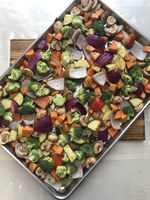Prairie Fare: Refresh Your Eyes with Wintertime Nutrition
(Click an image below to view a high-resolution image that can be downloaded)
By Julie Garden-Robinson, Food and Nutrition Specialist
NDSU Extension
“Look at all this snirt!” my husband exclaimed.
Our deep snowbanks were covered with dirt (“snirt”), thanks to the strong winds.
“I’m so tired of winter,” I replied.
He glanced in my direction. I read his mind.
“That’s an understatement,” he was thinking.
As we drove on that windy day, our world looked like a black and white movie. Fortunately, a colorful car or house punctuated the somber color of the outdoors.
Like everyone else, I am waiting for the snow to melt and the snirt to return to lawns and gardens.
Green blades of grass and leaves on trees will be a welcome sight.
We certainly can brighten our days by bringing nature’s color into our kitchens any season of the year. The natural pigments in foods have health benefits. In fact, we can help maintain our eyesight and prevent eye diseases through our food choices.
You might think of carrots and their association with eye health. Carrots and other dark orange and gold vegetables are a healthful option linked to reducing our risk of night blindness. Leafy greens and other colorful foods more often are linked to vision protection.
You may know someone with age-related macular degeneration. This is the deterioration of the central region of the retina called the macula. The “macula” is a region close to the optic nerve at the back of our eyes that allows us to see clearly and distinguish colors.
Macular degeneration is one of the leading causes of blindness, and scientists have found that diet can play a role in preventing this eye disease.
The macula lutea (Latin for the “yellow spot”) is composed of lutein and zeaxanthin. We literally feed our eyes with our diet. These pigments are found in colorful fruits and vegetables.
Lutein and zeaxanthin are carotenoids in the same group as the familiar beta-carotene found in carrots.
Kale, collard and spinach greens, orange bell peppers and corn are good sources of zeaxanthin.
Kale, green leafy vegetables, spinach, corn, peas, and yellow and orange vegetables are good sources of lutein. Egg yolks are another excellent source of lutein.
When you enjoy an omelet or scrambled eggs, chop up some bell peppers and toss in some spinach or chopped kale to double up on your eye-healthy pigments.
If you are a gardener, consider planting some vegetables that promote good eye health.
Inspire your gardening with programs offered by NDSU Extension and other Extension organizations across the country.
See www.ag.ndsu.edu/fieldtofork for registration information for our “Field to Fork” series, plus links to many resources.
You do not have to wait for a farmers market or your own garden. Enjoy colorful produce every day from the produce aisle, freezer section or canned goods aisle. All forms of vegetables and fruits count toward the recommendations: at least 2 1/2 cups of vegetables and 2 cups of fruit daily for most adults and kids.
You might see eye health supplements in the store, and some supplements have shown health benefits, especially for those lacking fruits and vegetables in their diets. Do your homework on supplements, and always let your healthcare provider know about any supplements you are taking.
However, aim for healthful foods before you drop the bottles of supplements in your cart.
Consider these tips from the National Eye Institute at www.nei.nih.gov to take charge of your vision.
- See an eye-care professional routinely. If you are age 50 or older, have a dilated eye exam annually or as recommended by an eye-care professional. Age-related macular degeneration, cataracts, diabetic retinopathy and glaucoma can be detected through regular eye exams.
- If you smoke, take steps to quit.
- Get regular physical activity.
- Maintain normal blood pressure. Do you know your numbers?
- Wear sunglasses and a brimmed hat when you are outside in bright sunshine.
- Wear safety eyewear when you are working around your house or playing sports.
This colorful recipe is a feast for our eyes and nourishment for our bodies.
Good for Your Eyes Roasted Veggies
2 cups sweet potato, diced into small cubes
1 red onion
1 red bell pepper, chopped
2 cups broccoli florets
1 yellow squash, sliced and quartered
1 zucchini, sliced and quartered
2 cups white mushrooms
2 tablespoons balsamic vinegar
2 tablespoons olive oil
4 cloves garlic, minced
2 teaspoons Italian seasoning
Salt and pepper (to taste)
Preheat oven to 425 F. Line a baking sheet with foil. Place sweet potatoes in bowl and add 1 tablespoon olive oil, 1 tablespoon balsamic vinegar, 1 teaspoon Italian seasoning, and salt and pepper to taste. Toss to combine. Transfer vegetable mixture (reserve bowl) to sheet pan and spread in single layer. Roast for about 30 minutes, then stir. Place remaining vegetables in bowl and add remaining olive oil, balsamic vinegar, garlic and Italian seasoning. Season with salt and pepper to taste. Toss to combine. Add to sweet potatoes on sheet pan. Roast 10 to 15 minutes longer or until tender. Roasting time may need to be adjusted depending on size of vegetables. Serve immediately. Note: Feel free to try different vegetables or different seasoning mixtures.
Makes 12 servings. Each serving has 80 calories, 1 gram (g) fat, 2 g protein, 10 g carbohydrate, 2 g fiber and 30 milligrams sodium.
(Julie Garden-Robinson, Ph.D., R.D., L.R.D., is a North Dakota State University Extension food and nutrition specialist and professor in the Department of Health, Nutrition and Exercise Sciences. Follow her on Twitter @jgardenrobinson)
NDSU Agriculture Communication – Feb. 24, 2022
Source: Julie Garden-Robinson, 701-231-7187, julie.garden-robinson@ndsu.edu
Editor: Elizabeth Cronin, 701-231-5391, elizabeth.cronin@ndsu.edu




